Episode 257: HubSpot CRM Suite Starter - What, Why and Who it's for
Welcome to HubShots Episode 257: CRM Suite Starter This edition we dive into:
If you're new to HubSpot, we guide you on where to start, how to do it right, and train you to make the most of the platform.
Review your HubSpot portal to uncover issues, spot growth opportunities, and ensure you're maximising its potential.
Unlock business growth with automation and attribution. Implement best practices and execute marketing campaigns.
HubSpot On-Demand
HubSpot Training
HubSpot Websites
HubSpot Campaigns
Virtual HubSpot Manager
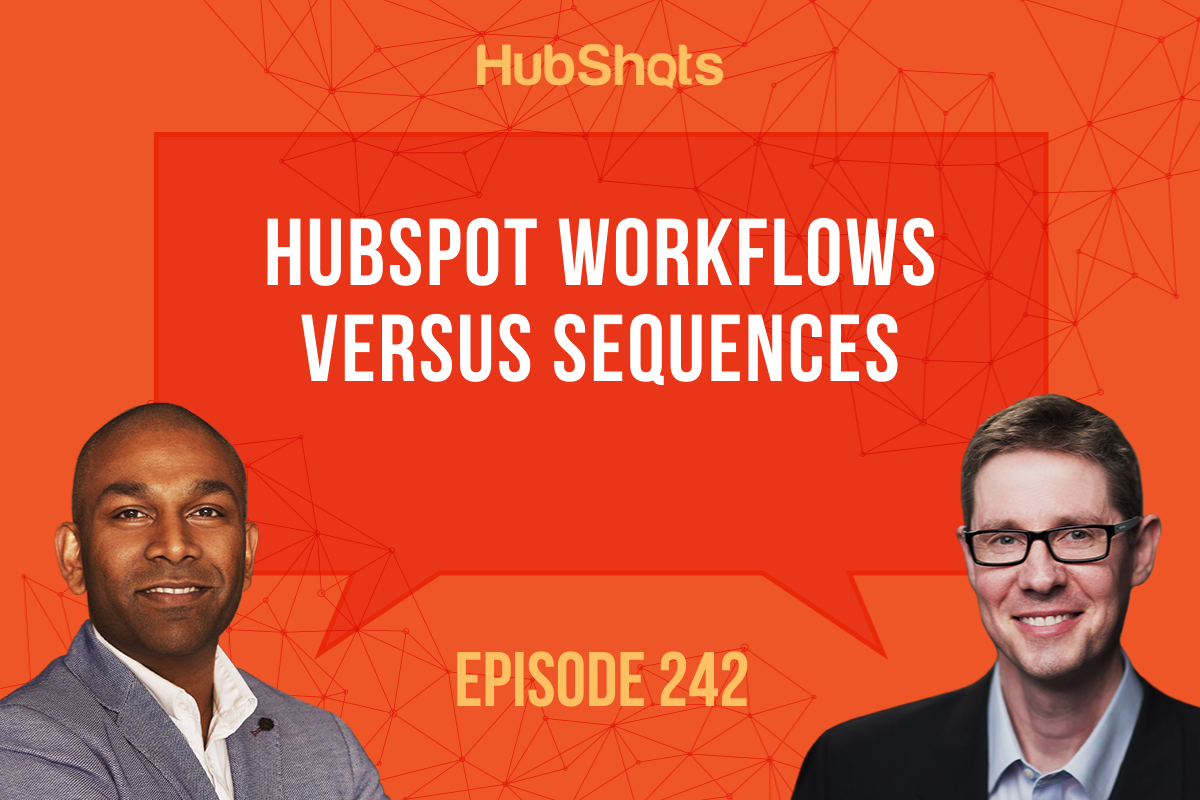
This edition we dive into:
You can listen to this episode of the show here.
Did a colleague forward this episode to you? Sign up here to get yours every Friday.
Please forward this on to your work colleagues.
Recorded: Monday 19 April 2021 | Published: Friday 23 April 2021
I realised a few years ago just how suggestible I was. Possibly quite gullible as well (at least that’s what people tell me lol).
This is one of the reasons I’m not on social much - a simple ad or post in my timeline often drives behaviours that I don’t really want (eg buying things, eating things).

For the last year I’ve been running an experiment on Twitter where I mute every single account that shows me an ad. My muted account list now runs into the hundreds. To the point that now I only ever see ridiculously untargeted ads from totally irrelevant accounts (which I also mute just for the completeness of it). Often the ads are in other languages because the inventory available to target at me by Twitter is now so low.
On one hand this is a lifehack you might like to try yourself.
On the other, it’s a massive opportunity for Twitter to fix.
But perhaps most importantly:
Take advantage of Twitter’s lack of advertising inventory
In terms of your marketing: be mindful of the limited ad inventory Twitter has (compared to Facebook especially, and Google generally). It could be a sign that there isn’t that much competition by advertisers on Twitter in your industry, and thus if your audience is potentially on Twitter, then definitely test and measure.
On another topic entirely...
This one’s a bit of a pet peeve of mine… it seems every company I interact with these days sends me a survey of some type (usually NPS) after the most minor of contact (eg rate our service after a 30 second web chat bot interaction).
I used to ignore most of them, but then they got annoying and I started marking some of them as spam. Which probably isn’t ideal. Or fair.
I tried unsubscribing, but most would unsubscribe me from everything - which isn’t what I want: for example I usually like to receive product update emails (ie new features).
Which brings me to my point: as a user I ideally want a way to opt out of just the survey emails (NPS etc).
HubSpot is good in how they provide Email Subscription Types for managing this. But this seems to be the exception, rather than the usual.
Here’s the takeaway: are you sending out surveys regularly? If so, make sure you offer the option to opt out of just the surveys. Otherwise you may be losing usually interested subscribers.
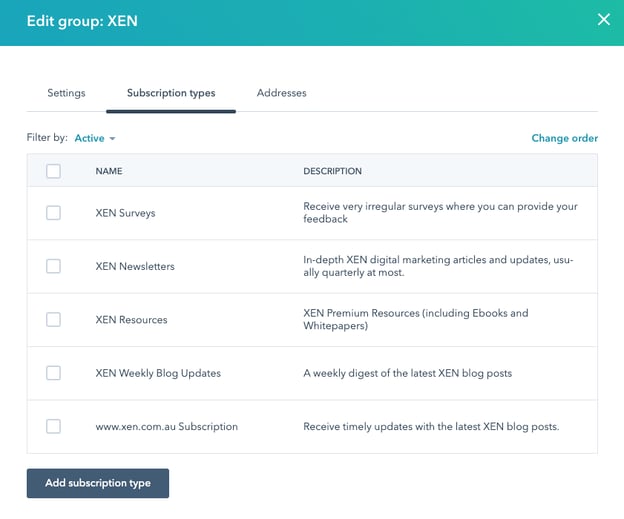
Here’s a few quick items of interest we noticed:
A quick little product update to note - you can easily add GTM into HubSpot pages now from the Pages settings:
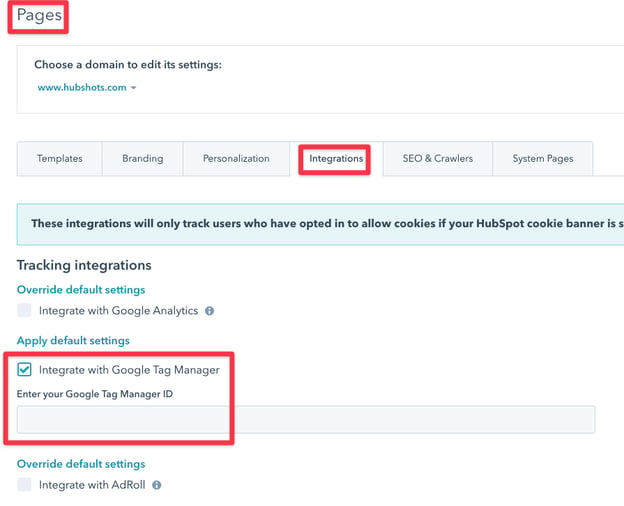
This may have been there for a while and I just didn’t realise (we were actually asking for this years ago - eg in episode 126 shot 2), but I’m really glad to see it in there now.
This is a comparison that often confuses users - when to use Workflows versus using Sequences.
We’ve discussed this in previous shows (listen to episode 110 for a good overview) but it’s worth revisiting.
BTW shoutout to Sera at HubSpot who reminded me about this when we caught up recently.
As she noted, we’re all busy, and thus automating (appropriately) where possible is a path to growth.
So, given we want to automate as much as possible, where do Workflows and Sequences fit in?
Here’s the quick rule of thumb:
Workflows are predominantly a marketing function, whereby you communicate (eg with email) in a 1 to many approach (eg email nurture sequence to a segment of your database).
Sequences are predominantly a sales function, communicating in a 1 to 1 manner, using a connected Inbox.
The confusion typically arises when a new HubSpot user discovers they can bulk enroll contacts into a Sequence. Ie essentially turning it into a 1 to many approach (and thus similar to Workflows). At that point they question which to use - after all, they just want to automate a series of emails to a segment of their database…
So, I understand the confusion.
At which point we drill into some of the additional features of each.
Here’s some scenarios for each:
Further reading from HubSpot is here.
This has proved particularly useful to make sure that items are not missed!
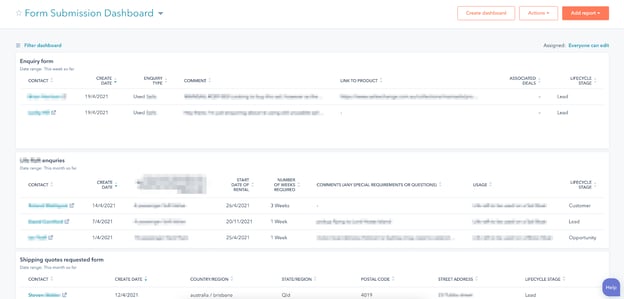
Coming into alignment with sales is the service analytics. So well worth a look and familiarisation.
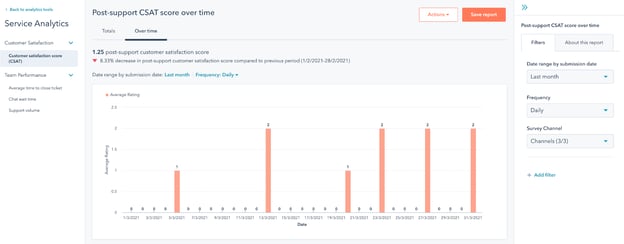
Further to the GTM integration option added (in Shot 2), I’ve noticed a change in how the header template options insert. Previously (and as we’ve mentioned on the show) you needed to insert scripts in both the Pages section and Blog section of Settings:
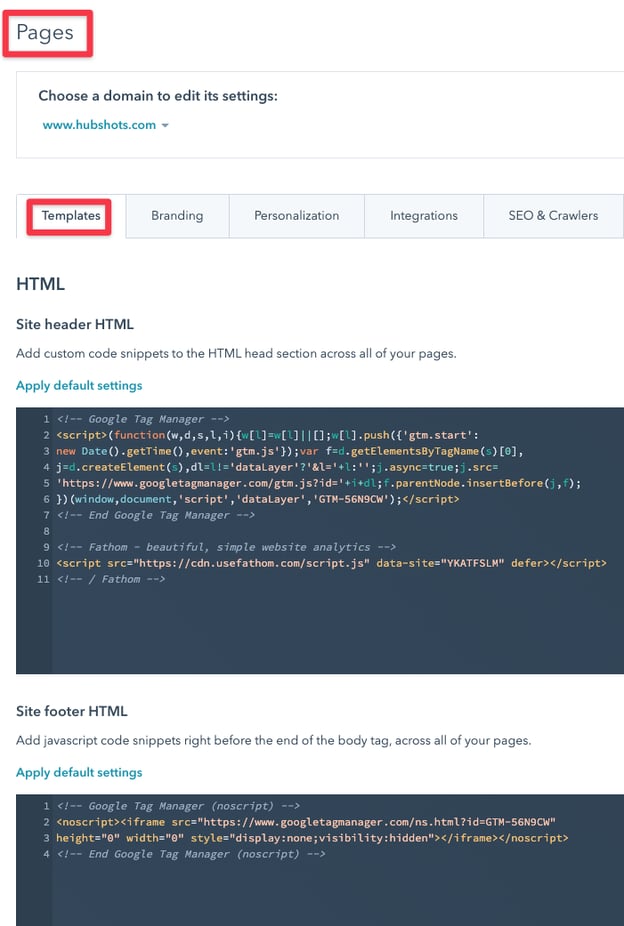
However, that’s no longer required - now you only need to insert in the Pages settings and that will be inserted into Blog pages automatically.
Why your excluded emails in HubSpot are getting logged in a shared inbox.
It’s because the Never Log Exclusion settings only apply to the Email integration (but not to the Connected Inbox):
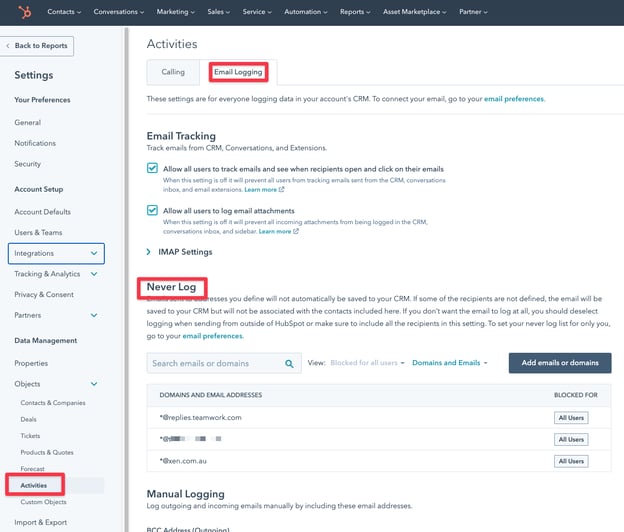
This is a question we are asked regularly - do I need to show those annoying Cookie Consent popups?
The answer depends on:
Specifically for Australia, where we are based (and predominantly target), it turns out we don’t have to.
Here’s the advice from Legal Vision - an Australian Legal advisory:
“Australian businesses that operate a website are becoming more aware of their customers’ concerns when it comes to privacy and data collection. Although the cookie consent pop-up is not a mandatory requirement in Australia, you should nevertheless be considering disclosing your use of cookies on your website by way of a privacy policy. This is particularly relevant if the cookie can collect personal information from the user.”
If you’re currently displaying those popups - perhaps you turned them on with everyone else a few years ago when GDPR rolled out - worth checking for your location and target audience - you may not need to.
I turned all ours off over the weekend (I had them running for a bunch of our brands). I’ve even turned them off for the HubShots site - and ensured our Privacy policy is up to date.

Some feedback I received (about how I often admit mistakes on the show): “Seems like you make a lot of mistakes…”
This caught me a little off guard and made me wonder if I was doing us a disservice by highlighting all the things we get wrong. Do listeners and readers associate us with poor quality as a result? Should I instead be presenting a polished public perception of our work, highlighting only the good things we do, and conveniently ignoring the failures?
I have to admit it has kinda unsettled me. And perhaps made me a little defensive.
After thinking about it, I’ve decided I’m fine with it - I’d rather be real and (hopefully) helpful, than trying to present as perfect…
A few notes to add to this though:
Further though:
We’ve seen other agency’s work when we take over HubSpot portals - some are terrible, and they are high profile agencies. So I know that we’re not the only ones who make mistakes.
On the other hand:
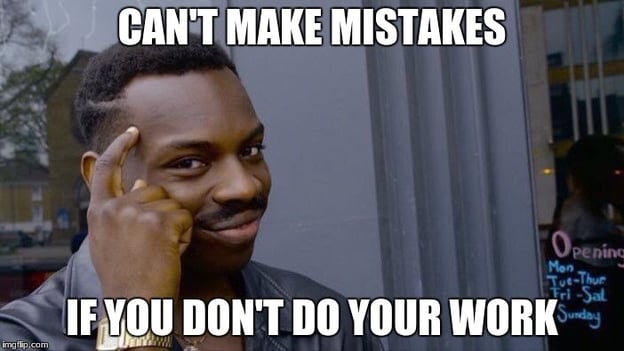
OK, enough about that. I hope you’re still with me.
Onto something more interesting.
Australia Post Parcel Lockers versus Amazon Hub Lockers
In Australia our postal service provides lockers you can get parcels sent to. You get a text or email to let you know a parcel has arrived and they are accessible 24 x 7 to pick up. Very handy.
However, they are limited by the logistics capabilities of Australia Post, which means they don’t do deliveries on weekends (seems crazy right, but that’s Australia for you).
Recently when using Amazon I discovered they had their own version of the lockers, in their case called Hub Lockers. This has likely been available in other countries for years, but in Australia is relatively new.
But here’s the big difference between Amazon’s lockers and Australia Posts’. The delivery timeframe to the lockers.
I purchased a book on Amazon on Saturday night, and when selecting an Amazon Hub Locker it indicated next day delivery. I chose that, and sure enough my book was in the Hub Locker at midday on Sunday.
Here’s the point: Amazon hit a limit - Australia Post’s capabilities. So what did they do? They built their delivery process.
Here’s the takeaway: A reminder to think laterally when you hit a limit (eg a marketing limit). What can you build to get around it.
Here’s one example: you hit a blocker because your target audience size is too small to meet ad platform requirements. What do you do? You augment with other audiences, even though they aren’t ideal targeting, just so you can reach your ideal audience.
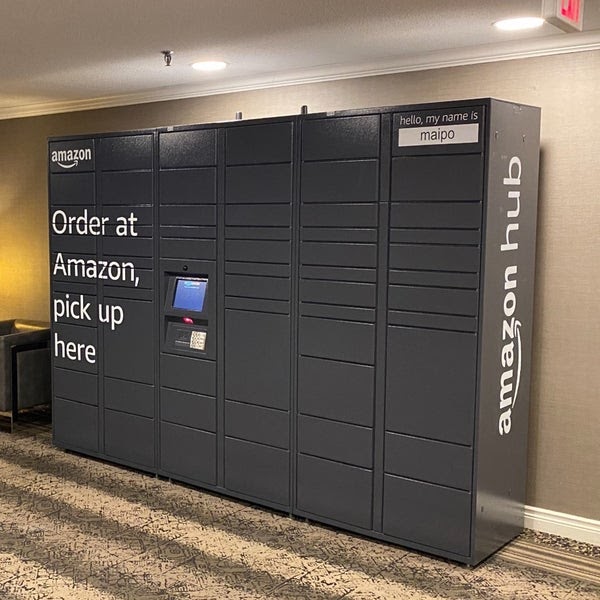
(Here’s what they look like - this isn’t my local one, it’s just an image I grabbed from Google)
Via the HubSpot product updates blog.
This time a year ago HubSpot was announcing Ticket Automation for Service Hub Starter. The enabled internal notifications and reply to Ticket emails.
BTW check out the new format for their monthly recap videos - HubSpot have decided to lift their game with the videos.
Google Shared some Technical SEO Best Practices For Ecommerce Sites via Search Engine Journal
“There’s plenty of competition for ordinary, but hardly any for exceptional.”
Interesting to see the trends in CMS usage over the years:
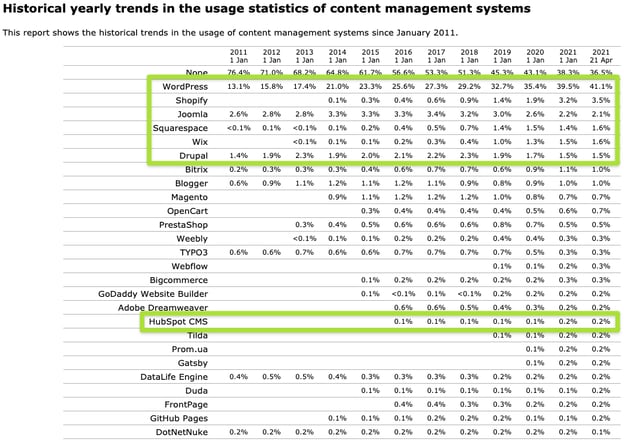
WordPress of course is the dominant player, but check out the growth from Shopify.
Also interesting to see Squarespace rising into 4th position alongside Wix. Looking at Squarespace’s recent S1 filing highlights they have 3.7M unique subscribers.
HubSpot (down at position 18) must be looking at this and seeing a whole world of opportunity - especially given how mature and easy to use HubSpot CMS is. More than a year ago when HubSpot announced CMS Hub Enterprise we mentioned (in episode 198) our surprise that there was no CMS Hub Starter version. We’re still scratching our heads...
This is a good overview of WordPress plugins that will slow down your site.
Confirming what everyone suspected, you can’t include phone numbers in Google My Business posts.
Facebook announced plans to develop a curated version of Instagram for kids under 13.
They got strong pushback to scrap it.
I can see both sides. On one hand I don’t want Facebook targeting kids with specific apps (I’m not a Facebook for any age groups actually - as listeners will know). On the other hand, the reality is that plenty of kids under 13 circumvent the rules and are on Insta (and other social channels).
So the question is: how do we protect kids? Sure, push back on an app specifically for them by all means - but please have an alternative solution to offer. At least a curated version is better than no solution (IMO anyway).
I love the idea behind this game - an Escape game with SEO related solving. Disclaimer: I haven’t even worked out the first part yet.
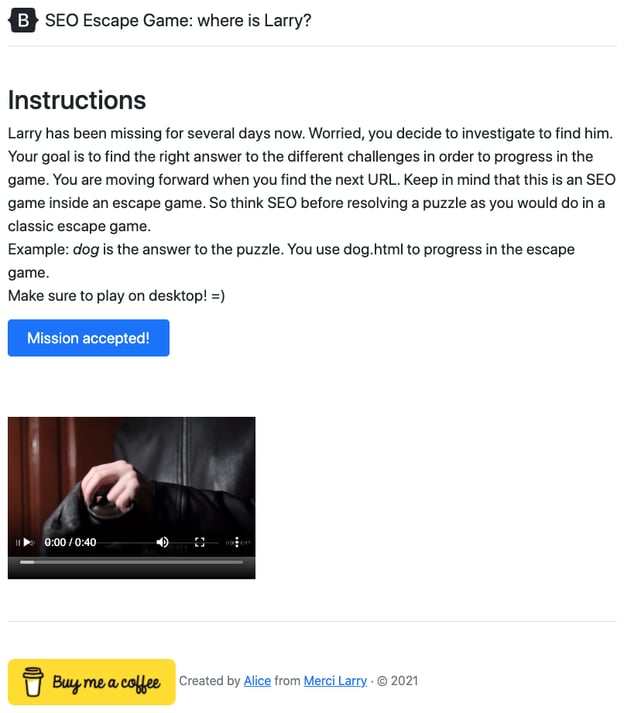
Moz discuss the different types of clicks that Google may (*cough*) look at in order to determine user experience.
TLDR; Be the first, longest and last click - here’s a pretty graphic for you
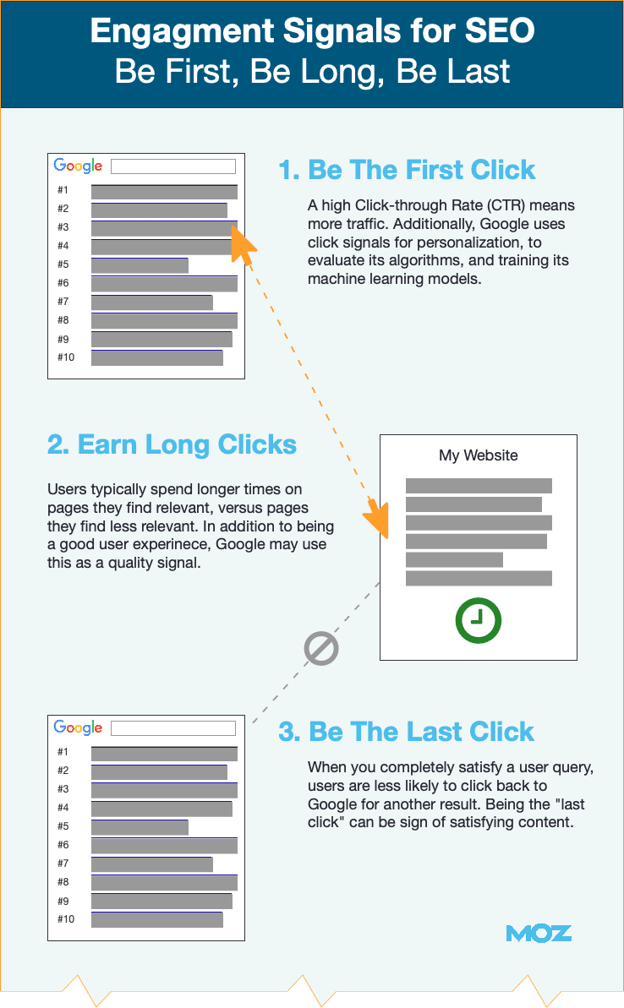
Be everything. lol.
Connect with HubShots here:
Connect with Ian Jacob on LinkedIn and Craig Bailey on LinkedIn
HubShots, the podcast for marketing managers and sales professionals who use HubSpot, hosted by Ian Jacob from Search & Be Found and Craig Bailey from XEN Systems.
HubShots is produced by Christopher Mottram from Podcastily.
Please share this with colleagues - it helps us improve and reach more marketers.
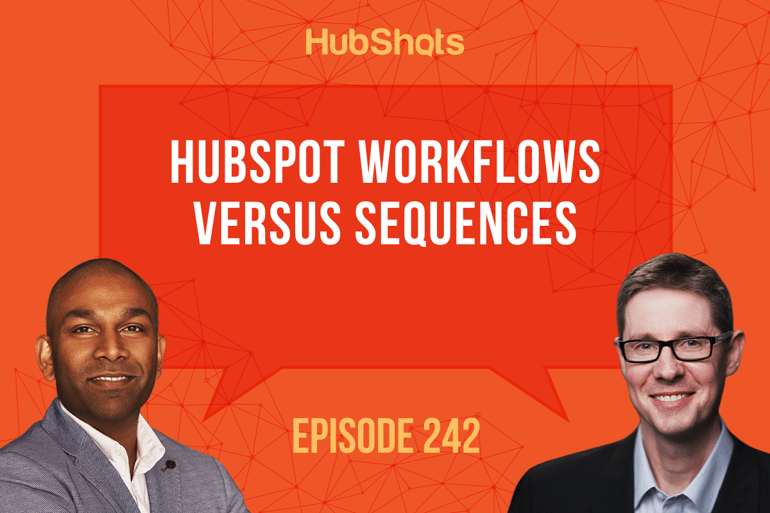
- [Ian Jacob] Hi, everyone. Welcome to "HubShots" episode 242. In this episode we talk about, HubSpot workflows versus sequences. Do you need to show the cookie consent pop-up? Dashboard for sales. Google Tag Manager in HubSpot. And much, much more. Including admitting mistakes. My name is Ian Jacob from Search & Be Found. And with me is Craig Bailey from Xen Systems. How are you, Craig?
- [Craig] I'm well. And, we're recording this in the afternoon. Normally it's a night. And that's because we caught up with Mads from DocuSign.
- [Ian Jacob] That's right.
- [Craig] Good to catch up with him. "Jeez" thought provoker, isn't he?
- [Ian Jacob] He is. Go on Mads. Now listeners, over the years you've probably heard of Mads. He used to be at HubSpot. And, one of their best sales guys. So we have a lot to learn from him. So we love catching up with him, soon. If you're listening Mads, hello. Now Craig, our growth thought of the week.
- [Craig] I've called this "Suggestibility and Twitter." Which might sound a little bit weird. Let me talk a little bit about myself. Cause you know, who doesn't love talking about themselves for a bit. But 'll explain why. So I'm very suggestible. I'm not saying this is a good thing. Ian in fact, I think I'm quite gullible. People used to say I'm gullible. Anyway. I kind of cottoned onto this a couple of years ago. By the way that's why I'm not really on social much these days. And I stay off Facebook, LinkedIn. I try and avoid it. Because, I've noticed in myself. It doesn't take much to prompt an action that I later think, "Oh, why did I do that?" "Why did I buy that?" "Why'd I eat that?" It just takes something even, well we don't watch much free to air TV. I see an ad for some snack food. And I'm like, "Oh." Suddenly I'm eating junk food. So I realize I'm very suggestible. I try and protect myself from a lot of these things. So the only social preamble to talk about Twitter. Because, Twitter is probably the only channel that I'm on. Now over the last year. I've been doing this experiment. Where, whenever I see an ad on Twitter. I mute the account. And I've been doing that for, well a year more. Anyway. If I look at now my muted accounts. It's in the thousands. I've actually basically just muted any time I saw an ad. So it's got to the point now, where I just see irrelevant ads. Often they're just in other languages. Or they're just for products that totally don't even relate to me. And so it's good. So I'm no longer suggestible based on the advertising, that's target at me. It's also by the way, why often pay. So for YouTube, I don't like ads. Yeah, I try inoculate myself from suggestibility. By the way, I don't think I'm the only one in this that has this problem. Perhaps I'm a bit more aware of it than others. Or maybe there's other people that are more, anyway. That all all brings me to Twitter. Because I was thinking, "Well, if it didn't take long to exhaust the inventory available to target me." Cause the ads are so poorly targeted now. It kind of indicates, "I wonder if the competition on Twitter is not particularly high." Whereas on Facebook I know it's never going to run out of ads to very accurately target at me. So I'm like, "Oh, I wonder if there's an opportunity here with Twitter." So, the reason for all that preamble, and all that thing. Is just through experience, I found this like Twitter. I think there's an opportunity there. And the other thing I'll say. I think this is an opportunity for Twitter. And so there's a reason their share price has been so low for many years. cause they don't know how to target. They don't know how to actually make money from their platform. So imagine if they could work that out. And crack that targeting better. I think there's an opportunity there. But, for us as advertisers. I still think there's opportunity in Twitter. So if your audience is potentially on Twitter, especially if you are in a tech related company or something like that. Maybe it's a channel to actually reconsider.
- [Ian Jacob] Now the second one you've got is, opting out of NPS surveys. And you said you wish there was a way to opt out of NPS, Craig.
- [Craig] You know HubSpot is really good. How they have email subscription types.
- [Ian Jacob] Yes.
- [Craig] Where you could opt out of just surveys or-
- [Ian Jacob] Correct.
- [Craig] So many surveys I get, don't have that option. There's one I'd serve, and I don't want to do it. So I actually just opt out. I don't fill out those surveys and NPS forms anyway. I think that's an opportunity for brands to just get on top of that. Because I'm basically unsubscribing. Cause I don't want those survey things. So if you're in the same situation as a business. And you're just pumping out survey results with no opportunity. Just opt out, of survey emails. Then perhaps you're doing yourself and your customers a disservice.
- [Ian Jacob] I totally agree Craig. Reviewing this with a customer of ours in the week gone past. And just discovering database hygiene. And understanding all these people that were unengaged. And what did we do about it, and how do we get them re-engaged or how do we clean them out? So we're not wasting space and time communicating with them. And having no response. So I'd suggest to listeners. Try something a little bit left and center. If what you've been sending them hasn't resonated. Try something totally different to get their attention. And to find out which way they want to go. Cause I'd rather have, no and yes. Rather than have no answer at all. All right onto our quick shots of the week. And here's one. Further to our shot last week. The SEO audit talk now. Officially check both HubSpot hosted and external websites for seven new issues across categories like performance accessibility and user experience. And these recommendations will make it easy for you to build and maintain your website. That adheres to the webs practices. For good experience for your visitors. And this is tied to the Google roll-out. Which is about to happen over the call web vitals that we've been talking about. And about experienced people are going to have while they travel around your site in the web. And the second thing is. Listeners you need to sign up for the "HubShot's" marketing 28 day challenge.
- [Craig] Well, at least a sign up, If you're interested. We've talked about this on the show. And this is a new program that we're going to be offering. And basically here's the pitch. If you've had HubSpot for more than six months. And you still don't have a campaign running in market. Then, this is going to solve it for you. So it's an interactive working with us as part of a group to get a campaign in market. Now we have a Landing Page. You can go and click through. At this point we're just asking for expressions of interest. You're not committing to anything. We've just got a form with a few questions. When you'd like to do a time zone, et cetera. Let us know. And also any questions you can find out about it. Link is in the show notes.
- [Ian Jacob] All right. Onto to HubSpot marketing feature of the week, Craig. And a Google Tag Manager option in HubSpot CMS.
- [Craig] Yeah, just mentioning this briefly. Cause it's going to come back in a later shot when we talk about it in "gotcha." But previously we manually used to put the Google Tag Manager scripts into the header in both blog and the pages. Well now there's just a checkbox. Like there has been for Google analytics for years. But now there's just the GTM one. Just put your GTM code in. And it'll insert it both in blog and web pages.
- [Ian Jacob] Which is fantastic. So listeners, if you haven't checked your settings in a while. I'd encourage you to go through this. Have a look. And sometimes we've seen people have analytics and GTM both in there. So I encourage you to insert analytics through GTM. And take that out of HubSpot.
- [Craig] And by the way this GTM setting, it's that new?
- [Ian Jacob] Yes, it is relatively new.
- [Craig] Yeah, cause I didn't see an announcement about it. I just noticed it. And I know we've been wanting it for ages. But yeah, it's great. I wasn't sure if it had been there for ages. I don't think so. But that's great.
- [Ian Jacob] Alright. Now on to our HubSpot workflows versus sequences, Craig.
- [Craig] Yeah, I wanted to talk about this. Because it's actually a common problem, isn't it Ian?
- [Ian Jacob] Absolutely. And we covered this back in episode 110. Which seems like forever and a day. But, really what we're really seeing across the board is, everyone is busy. And what can we automate, right? So I want to go back. Workflows in terms of automation is in the marketing side. It's a one to many action, right? So, you're sending in out from your company. Or you could be sending in from the user. But, that one action is going to get sent out to a list of people. A sequence is in sales. And it's a one-to-one action. So what you do is. You will set up the sequence. Which is going out to that one person, before. You're basically pre-fill all the steps that you need to take place. Or you need to edit it for that person. And then you would trigger it off. And it gets sent out from your email or the task gets put into your queue. Now in saying that. You can do a bulk and roll on sequences on multiple contexts. You could see, think of that's obviously something that people might go, "Oh, hang on." "But that sounds like a workflow." Because we're doing it in a one to many aspect here. So yes, it potentially could be. But I think we need to really come down to understand that sales are probably going to be using sequences more often. And a really good example of this, that we've seen recently. Is people using sequences in sales for estimation follow-up. So they've sent the estimate. And then instead of forgetting about or putting a task in. They'll send, the first action might be a task to follow up. The next might be an automated email. And then they might have another follow-up task. Post that to maybe make a call and find out what's going on. So that's been working really well. And we've seen customers implement that really well.
- [Craig] Yeah, I'll just make a comment. Cause I think there is confusion with HubSpot customers about which one to use. I think it's understandable actually. Because they often get conflicting advice, shall I call it. Or suggestions. From actually HubSpot when they're talking. Now I will tell you how this often happens. So it depends who HubSpot is talking to. Are they talking to the person in the sales team? Or they're talking to someone in marketing? So depending on where they're talking from, someone in sales. They'll actually say, "Oh, you want to send bulk emails out." And the HubSpot customer say, "Ah yeah, I think marketing was doing that using workflows to automate it." And they'll say, "Oh no, no." "You know you can use sequences." And exactly like you said, we can bulk and roll. And so we've got a customer that had like a thousand people in the end. HubSpot was telling the salesperson, "Oh yeah, you can bulk and roll, during the sets of a hundred." "And you can get 3000." "So you should be using sequences." So then they're talking with marketing. And marketing is saying, "Oh, hang on." "No, no, I think we're doing that with workflows." Then they're chatting with us saying, "HubSpot is telling us to use sequences instead of workflows." So you can see how it's happened, right? It's gone from HubSpot wasn't actually saying, "Oh here's two equal options." "And we're telling you to go sequences." Just happened who they were talking through, the message kind of when it made it through. So there's confusion in the customers. So I think that's really good that you highlighted where it mainly sits at sequences. And mainly with sales. Workflows mainly with marketing. You can use them both though.
- [Ian] And listeners, just thinking back. If you're sending a sequence, it's usually a sequence of tasks, calls-to-do. And an email that's sent out from you. Now these emails don't look polished like marketing emails. Because they look like they're coming from you. So they're made up of templates within HubSpot. Which are email templates. Whereas in a marketing perspective. You could have a stylized marketing email that goes out. So that's probably a really big distinction between the look and feel of what the end user's getting. And how it's being executed on the inside.
- [Craig] I think that's right. Let's look at both though. What can both of them do? They can do a sequence of emails. They can put in delays. And they can do those things. But on workflow side versus sequences side. There's various features that favor each of them.
- [Ian Jacob] That's right. Let me take for example, a marketing workflow. Let's say we've got a email series that's educating people about a particular topic. And you might say in this series, we've got four emails that goes out. And in between you might actually put a task in there for sales to give a call, right? After the series is going out. So two emails go out. We put a task in the workflow saying, somebody in sales needs to just have a look at this contact. Maybe fill up with a call. Depending on how they've interacted or opened up the first two. And then the next two emails go out. That's the workflow, right? In sales, in a sequence what happens is that, let's say we do the exactly the same thing. We're going to put somebody in a sequence, two emails go out. We're going to put a task to call them. And then following to guide. Now, after the first email going out in the sales sequences. If say for example, Craig you respond. This sequence was now broken. The person is not going to get the next email. The next task is not getting put in the sales person's queue. And neither is anything beyond that. That is the really big difference between the two.
- [Craig] That's a powerful thing, yeah. Reply, drops them out. On workflow side, back on the marketing side. There's other features. We won't dive into all of them. But just seeing a branching. It could do branches. 20 different branching. All those kinds of things. Interactions with other platforms, Trello. And things as well. There's a whole lot of other additional functionality and workflows. We won't go into that now. Cause it's probably over-complicate them. But yeah, just remember that. Think one to many versus one-to-one. One to many workflows. One-to-one sequences.
- [Ian Jacob] All right. On to our HubSpot sales feature of the week, Craig. And this is, something came out of a necessity when talking to a customer of ours. They've got all of these forms coming in. They're trying to keep on top of everything being answered. And they were just like, "How do we keep a track of all of this?" So, we created a dashboard of all of these key aspects. That shows them particular types of inquiries. Because they're going to different people on the team. So they can look very clear and go, "Okay, for this week we've had this many people fill out the inquiry form." They can hover out and they can see what the inquiry was about. If are some people in this case are requesting shipping estimates. That's on a separate widget. And then there's another one. They've got a rental product. So who's asked for a rental? And what is the date they requested it? So we put that all, so they can see really clearly without having to go through each form and figure out, "Oh, what's happening here?" They can get a nice overview of what's going on at that particular point in time. All right, onto our HubSpot service feature of the week, Craig. And this is service analytics. And this is nicely coming into alignment with the sales side of the tool. And I would suggest it's a well worth a look in familiarization. Now listeners, you need to make sure you've got Service Hub Professional to have these tools just like you have Sales Hub Professional. And it looks very similar. And they've got some interesting things in there. And just really again, here it's these little increments that bring everything back into line. Make it nice and uniform across a platform. So again, it's at the early stages. But I just want to highlight it. Because people can easily miss it. But it's a great place to start.
- [Craig] Continual incremental improvement. I love it, Ian.
- [Ian Jacob] All right. Onto our HubSpot "gotcha of the week, Craig.
- [Craig] Well, following on from earlier when we mentioned Google Tag Manager in the HubSpot settings. To go into pages and blog posts. Which is fantastic. I realized that, well it's actually really good now. But previously we actually had to add the Google Tag Manager scripts manually into the header template. And you had to do that on the pages side. And the blog post. So in previous episodes, I know probably five, 10, 20 episodes ago. We'd say, "Oh, just remember a gotcha was, oh when adding Google Tag Manager." "Make sure you add it both into pages and into blog posts." Well now, I'm happy to say. You don't have to do that. You don't need to, well first of all. You don't need to manage and send them into the header templates. Two. You just need to tick that checkbox and put your GTM code and takes care of it. So the "gotcha" is, well I had to go through all our sites that are hosted. And remove the scripts from the blog. Cause they're getting added twice. Cause it had a template. And I also put it into the pages setting. So that's the little "gotcha." But it's a good, "gotcha." I think it's an improvement. And it's also a reminder you need to go back and review these things.
- [Ian Jacob] And the next one listeners. I wanted to tell you about was inbox logging, excluded email domains in HubSpot. And this is because your email comes into the shared inbox. And it can't decipher from that point. And so it logs everything in a system that is included on a particular email. And so just in case you're like, "Hang on I just excluded that." "Why is it appearing now?" That's the reason why. And, there will be some support articles that I'll share in there. Just to make sure how you can filter things correctly.
- [Craig] You know, what we should do another "gotcha" around people getting confused between connecting their inbox to log to HubSpot. And, to connecting their own email address into the inbox, conversations inbox. We had a client, actually quite a large client. Someone in the team. Instead of just connecting to log from Gmail into HubSpot. That actually connected it and all their company emails were appearing in the inbox for anyone to see in the conversations inbox. So yeah, a little bit of "gotcha." Maybe we should clarify that next week, next episode.
- [Ian Jacob] All right. Marketing tip of the week. Do I need to show the cookie consent pop up? And this was a question from one of our clients. They are a global business. But their business in Australia operates here, its own entity. And they serve Australia and New Zealand. So they were like, "We need to put this consent pop-up saying that we're tracking everything." And I was like, "Really?" And we had this conversation. And so you found the answer, Craig.
- [Craig] I actually got legal advice on this. Because I wasn't sure. And the answer is it depends on the country you're in. So this particular answer is just for Australia. If you're an Australian business. Even though your site might be global. As long as you're not specifically targeting the EU or California for that matter. You do not need a cookie consent pop-up. You just do not need it, under Australian law. However, you probably do need to include mentions of it on your privacy policy page. If you are collecting that kind of information. But you did not need a cookie consent. Anyway that's just Australia. And you should probably get legal advice. I've actually put a link here from LegalVision. Where they specify this. However for other countries. Go and do your research. Because, I see it on every single website. Everyone's got a cookie consent pop-up. Including most of the Australian sites I go to. They actually don't need it. And perhaps you don't need it either. So just, this is not legal advice. This is just a mention to go and get legal advice about it.
- [Ian Jacob] All right. Our insight of the week, Craig. "Admitting mistakes."
- [Craig] So I got feedback about some of the things I say on the show. And it says, "It seems like you guys make a lot of mistakes." And it was said as a bad thing . As if, yeah. As they were kind of sloppy and incompetent. And I felt awkward about that. I don't know how you felt about it, Ian. But I was like, "Oh, is that the impression I'm giving?" That we're not very good. But I kind of feel it's helpful. I actually think, well you know how you can write a book and say, "Oh, I've made heaps of mistakes." Or there's almost a, "I've failed." "My first business failed." People can say that. But apparently the difference is, if he gives specifics. Which we do on the show. We talk about specific things we get wrong. And that associates in people's minds are, "These guys aren't very good." So I was aware of that. I'm like, "Ah, are we misrepresenting ourselves on the show?" Anyway, I've decided I'm actually okay with it. I think it's more helpful to our audience to talk about the things we stuff up. Given that they then might learn from it. And not stuff up and follow that mistake. And the other thing, isn't it just a plan of improvement?
- [Ian Jacob] Exactly.
- [Craig] You make mistakes. And whether you trumpet them or just admit them. You grow. And so, yeah. So anyway. We're going to continue to do it, so folks.
- [Ian Jacob] I think Craig. We operate in an industry, in a sector that is constantly changing, right? I remember when I was at university and the head of the faculty said, I still remember it very clearly. The first day I joined. She said, "You know what you're gonna learn today is going to be obsolete tomorrow or next year." "And then in the third year, it's just going to be obsolete again." She goes, "What you have to be able to do is have a framework to work this out." "And to figure out the solution." She goes, "That's what you're going to end up leaving here with." And that's been my life. And I'm sure your life up until this day of us having to work things out. And figure a way through something. Because none of the things we do here, has been chatted before, right? So I'm sure some things have been. But a lot of them haven't. And we're constantly pushing the product or doing things and trying things that people haven't tried. So yes, things don't work . Or they don't work like we expect it to. Because we're expecting a particular outcome. And we're okay with that. We then try to find another way to get the outcome that we're after. So listeners, like I said. I think we operate in this world. And it's not 100%. And we're okay with that. And we just want to share our experiences along the way. So we can help you avoid the things that we're trying testing and trying out. And you can get to the end quicker.
- [Craig] This is exactly right. I want to say two more things. The first is, and cause I'm feeling a little bit defensive. I'm like we take over, like we're brought in to fix HubSpot portals. And we've taken over portals from very well-known agencies. And we see some of the stuff they have set up. And it's like really bad, okay. So even the best agencies we're kind of surprised sometimes how bad their set up is. The second thing I want to say though is. Sometimes we go back into our own portals for clients we set up years ago. And I go, "Oh my goodness, this was terrible." Well, not terrible. But like we've improved so much more. So, it is continual learning. And that's why I'm kind of very sympathetic to other agencies. Cause they're probably like, "Yeah we've learned and we do stuff much better now than we did before." I mean, we probably charged about a third as much as we do now. It was probably a good value at the time. But we're actually quite expensive now. But back then it was probably still okay. But it's so much better now. And I think this is the case with our agency. We've seen other agencies do it. So I'm very much the case, everyone makes mistakes. I'm happy to say, we make tons of mistakes. And I'm happy to share them if it helps our listeners do better.
- [Ian Jacob] And I think the other thing Craig is that I've discovered is that. we've come from a technical background as much as I don't like technical, some technical things. Like I used to code. But it wasn't my favorite thing to do. I love other things. But you know what, that's given me a foundation of how to organize things correctly. How to think instructor things correctly. And that comes back into the portal when we're doing things. It's like, have we organized, have we thought about this structure correctly? Have we thought about the types of objects we're collecting. So we're thinking through all of these things. We're not just thinking, "Well, how do we get to the end?" But we're thinking about how do we pave the road well. So we're not fixing all this potholes constantly on the road.
- [Craig] Yeah, actually that's a good way. You know what? I wish I had said this when I got that feedback there. I kind of feel I'd say, "Oh yeah, we make lots of mistakes and we're going to continue to." But the difference is we don't make the same mistakes.
- [Ian Jacob] That's right. Did you want to talk about the Amazon Execution, Craig?
- [Craig] Just quickly. I know Australia is behind the US. So this is probably just table stakes for the US. But, I was amazed, you know get Amazon. Get everything delivered. They're very good. But on Saturday night I was ordering a book. And just to get it normally delivered through Australia post. Or delivered by Wednesday. And there's like, "Oh, Amazon have lockers." I'm like, "Oh, what are these?" Anyway. Amazon set up their own little lockers in various places around world. So I choose that. And I said, "Ah, you'll have it tomorrow." I was like, "What?" Anyway. Sure enough, I went through. So I'm ordering it Saturday night. And then I get a message midday, Sunday. It's in the hub locker. And I picked it up that afternoon. I'm like, "Oh wow." So my point is. They've hit a limitation with Australia's existing infrastructure, Australia post. So they've just said, "Oh, well we're not going to let that limit us." "We're going to build our own infrastructure." Put our own logistics in. And I know Amazon is well known for this. Especially in the US. And I'm just like, "Ah." The insight or the takeaway for me is. I quite often hit limitations in advertising platforms or different technology platforms. That's like, "Ah." This is incentive for me to take the attitude, "Ah." That's a limitation most people won't try and change it. Because all the other E-commerce businesses in Australia, they're not trying to improve it. They're just like, "Oh, we're at the mercy of Australia." I don't want to be like that. I want to be like Amazon. It's like, "Oh, how can I get around that?" So I was thinking particularly the one that often gets us this audience sizes. So LinkedIn. Or trying to put a re tagging, you can't get it. So how do you get around it? Well, one way is you actually build out a large audiences that you know, and not a full strike rate. But at least we'll get you over audience sizes. So, the people in that audience that you did want to target will be a great. So there's little tricks and ways around it. But I think it's the attitude that's important. Don't let existing limitations-
- [Ian Jacob] Stop you.
- [Craig] Stop the results that you're gonna to get.
- [Ian Jacob] All right. The "HubShots" throwback of the week, Craig. And this time a year ago HubSpot was announcing ticket automation for Service Hubs Data. Wow. That enabled Intel notifications. And reply to ticket emails.
- [Craig] Just a year ago.
- [Ian Jacob] Wow.
- [Craig] It's come so fast since then.
- [Ian Jacob] Sure has. And today we talked about the new analytics. All right. Now we go to resource of the week. Google shares technical SEO best practices for E-commerce sites and via search and in general. So listeners have a read of that. I think it was rather good. And the quote of the week, Craig.
- [Craig] I like this quote. I'm not exactly sure where it's from, originally. It was in a book I was reading this week. I can't remember which one. But the quote was. "There's plenty of competition for ordinary." "But hardly any for exceptional."
- [Ian Jacob] I love that quote. Our listeners, again. Subscribe to the show notes. They're some bonus links in there for you. For those who subscribe.
- [Craig] Yeah. A bunch of interesting topics. Ones around WordPress Plugins to avoid. Cause they affect performance, inside spade. Got another one, Google my business updates. And not being able to include phone numbers in actual posts on GMB. So look at that. And then, have you seen this? "Where is Larry?" It's an SEO escape game. I won't say more. Just check it out in the show notes.
- [Ian Jacob] I'm going to go have to play that on the way home Craig. And listeners, again. Thank you for listening. And if you can share the show with anybody else that is either considering HubSpot or is using HubSpot that would greatly help us. Until next week, Craig.
- [Craig] Catch you later, Ian.
- [Ian] Hey there. Thanks for listening to this episode of "HubShots." To get the latest show notes, HubSpot tips and marketing resources. Sign up at hubshots.com. You can also book time with us to help you grow better with HubSpot.
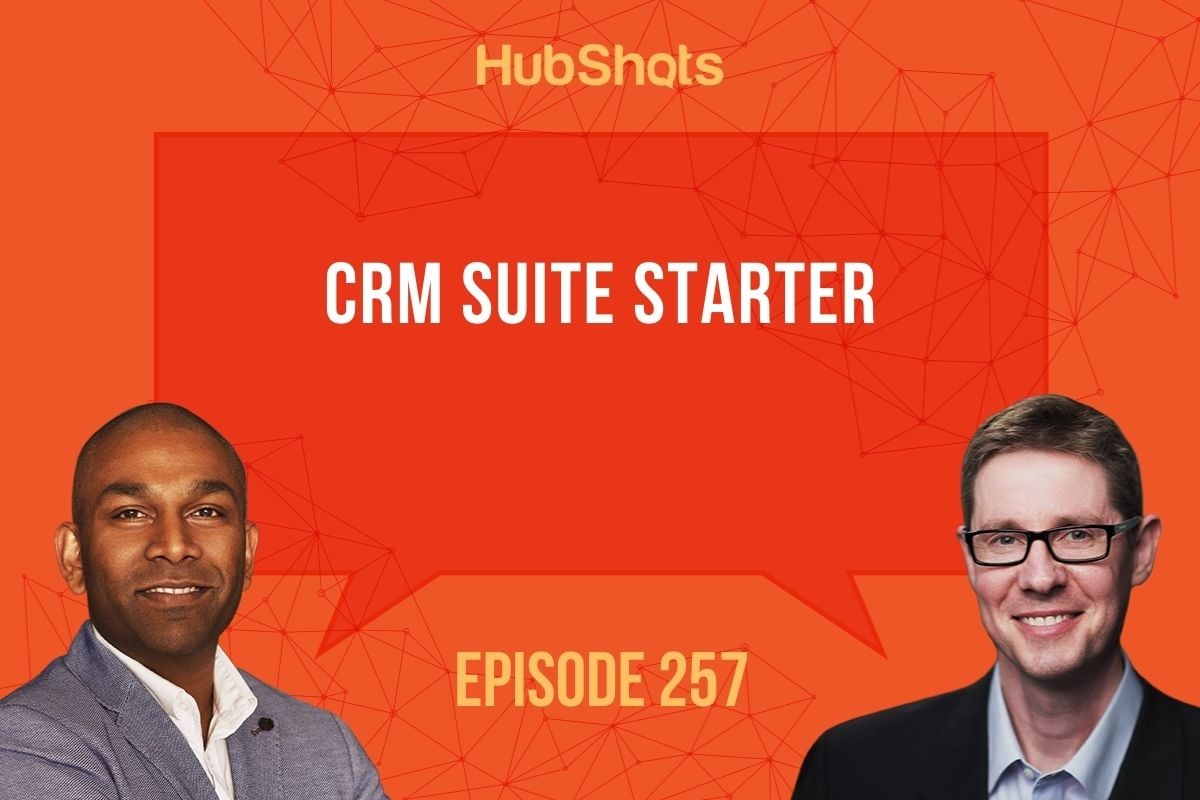
Welcome to HubShots Episode 257: CRM Suite Starter This edition we dive into:
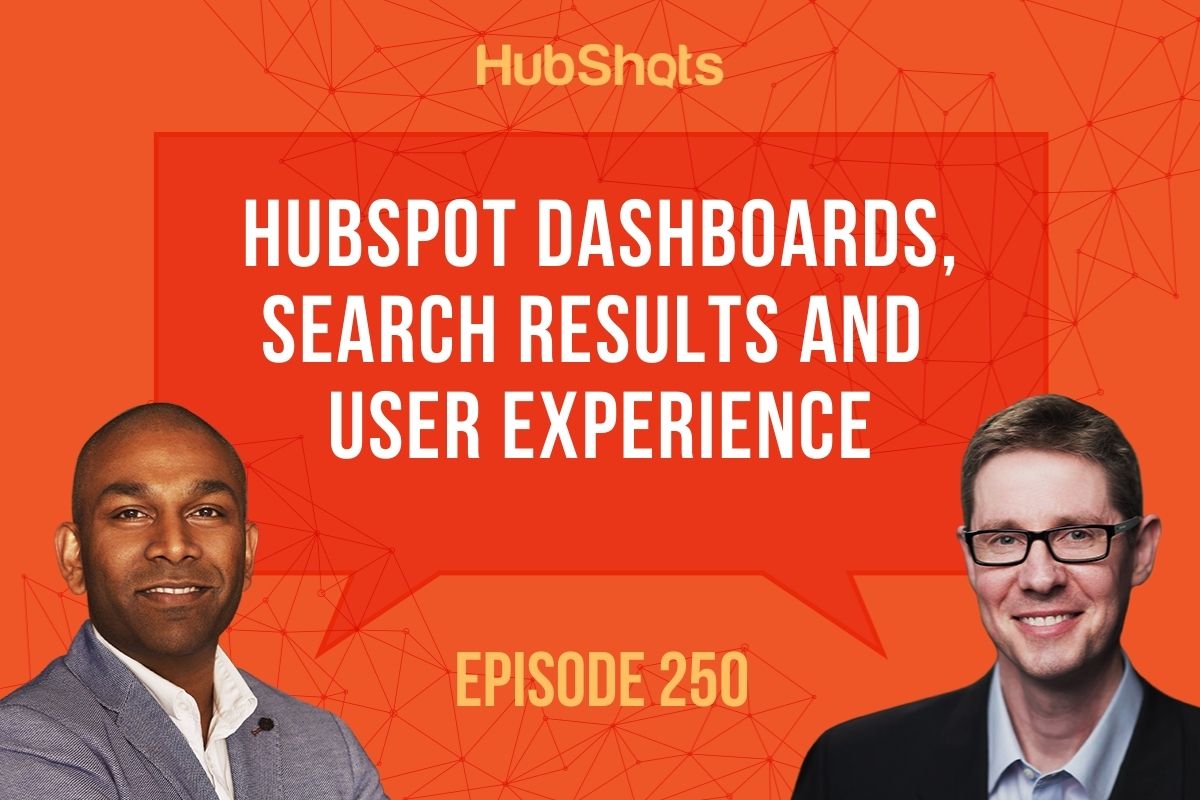
Welcome to HubShots Episode 250: HubSpot Dashboards, Search Results and User Experience This edition we dive into:
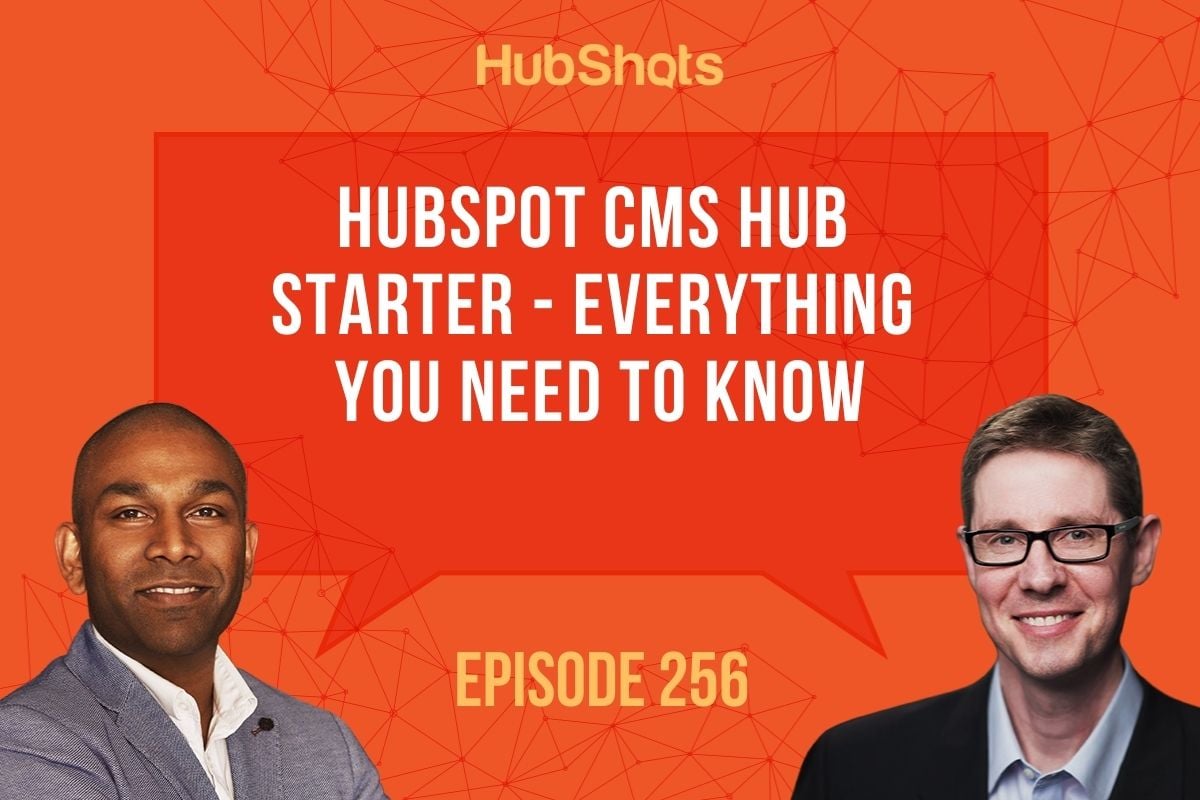
Welcome to HubShots Episode 256: HubSpot CMS Hub Starter - Everything You Need To Know This edition we dive into: